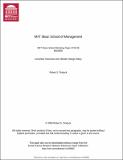| dc.contributor.author | Pindyck, Robert S. | |
| dc.date.accessioned | 2011-11-04T19:57:04Z | |
| dc.date.available | 2011-11-04T19:57:04Z | |
| dc.date.issued | 2009-08 | |
| dc.identifier.uri | http://hdl.handle.net/1721.1/66946 | |
| dc.description.abstract | Focusing on tail effects, I incorporate distributions for temperature change and its economic impact in an analysis of climate change policy. I estimate the fraction of consumption w*(τ) that society would be willing to sacrifice to ensure that any increase in temperature at a future point is limited to τ. Using information on the distributions for temperature change and economic impact from studies assembled by the IPCC and from “integrated assessment models” (IAMs), I fit displaced gamma distributions for these variables. Unlike existing IAMs, I model economic impact as a relationship between temperature change and the growth rate of GDP as opposed to its level, so that warming has a permanent impact on future GDP. The fitted distributions for temperature change and economic impact generally yield values of w*(τ) below 2%, even for small values of τ, unless one assumes extreme parameter values and/or substantial shifts in the temperature distribution. These results are consistent with moderate abatement policies. | en_US |
| dc.language.iso | en_US | en_US |
| dc.publisher | Cambridge, MA; Alfred P. Sloan School of Management, Massachusetts Institute of Technology | en_US |
| dc.relation.ispartofseries | MIT Sloan School of Management Working Paper;4742-09 | |
| dc.subject | catastrophic outcomes | en_US |
| dc.subject | global warming | en_US |
| dc.subject | climate change | en_US |
| dc.subject | Environmental policy | en_US |
| dc.title | Uncertain Outcomes and Climate Change Policy | en_US |
| dc.type | Working Paper | en_US |
